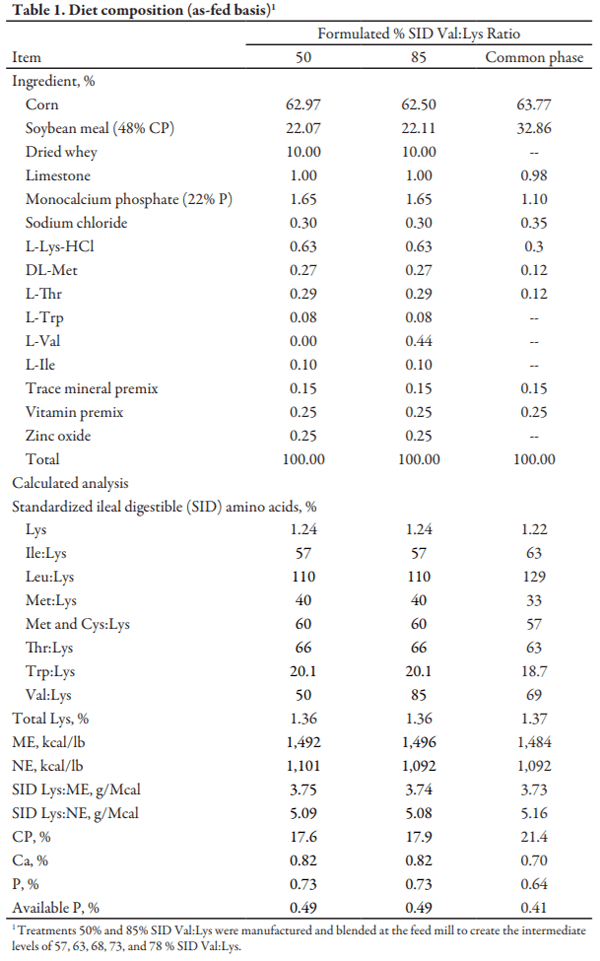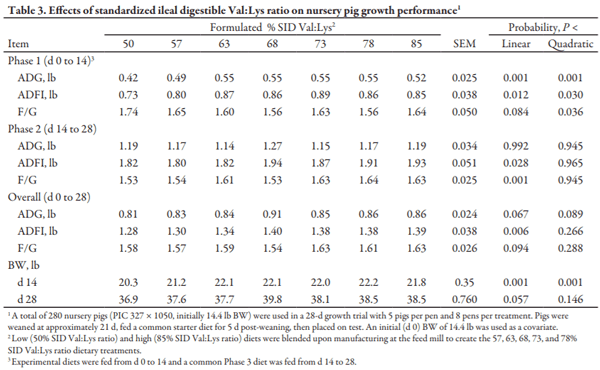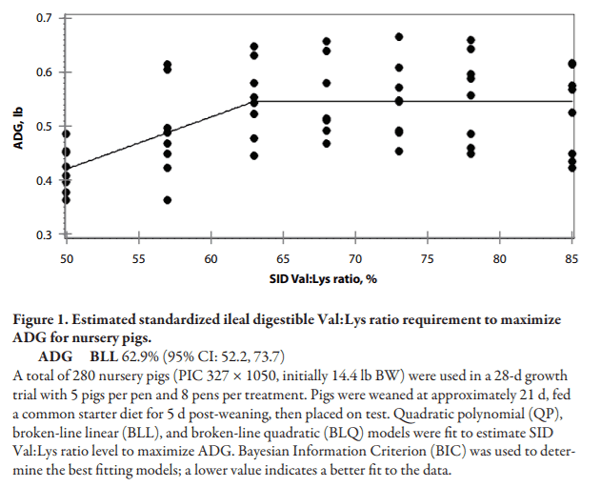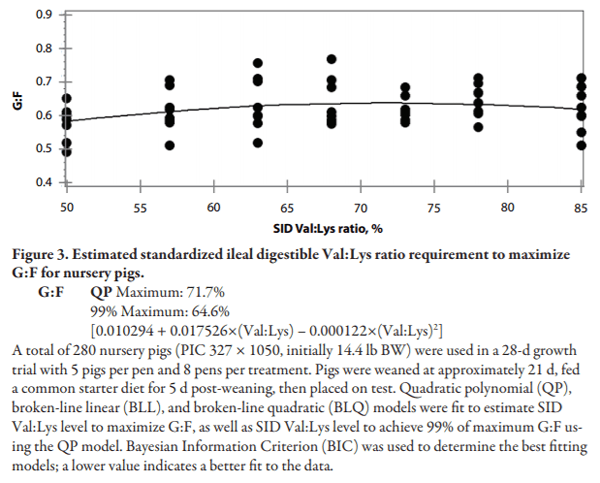Introduction
Inclusion of dietary crystalline amino acids is a common practice in the swine industry. This is done to meet specific amino acid requirements while reducing feed cost and environmental impact. Additionally, amino acids are often expressed in relation to lysine to develop the most efficient diet formulations. A previous experiment conducted at Kansas State University validated that the lysine requirement for 15 to 25 lb pigs was 1.45% SID lysine. Therefore, our next step was to determine the appropriate SID Val:Lys ratio for pigs in this weight range.
The NRC (2012)1 estimates that the valine requirement for approximately 15 to 25 lb pigs is 63.7% SID Val:Lys, while Nemechek et. al (2014)2 determined that 65% SID Val:Lys was necessary for optimal growth of 15 to 25 lb pigs. However, pigs in this experiment were fed at the Lys requirement for ADG, which may underestimate the Val:Lys requirement. Therefore, the objective of this study was to determine the SID Val:Lys requirement for nursery pigs weighing approximately 14 to 22 lb when fed marginally below their dietary lysine requirement.
Procedures
The Kansas State University Institutional Animal Care and Use Committee approved the protocol used in this experiment. The trial was conducted at the Kansas State University Swine Teaching and Research Center in Manhattan, KS. All diets were manufactured at the Kansas State University O.H. Kruse Feed Technology Innovation Center, Manhattan, KS. Corn, soybean meal, and whey were analyzed for amino acid content prior to diet formulation (Ajinomoto Heartland, Chicago, IL).
A total of 280 nursery pigs (PIC 327 × 1050; 14.4 lb BW) were used in a 28-d experiment. There were 8 replicate pens per treatment and 5 pigs per pen. Pigs were weaned at approximately 21 d of age and allotted to pens according to BW and gender. A common Phase 1 starter diet was fed 5 d post-weaning. On d 5 after weaning, pens were allotted to 1 of 7 dietary treatments by BW in a randomized complete block design. The 7 dietary treatments were formulated to contain SID Val at 50, 57, 63, 68, 73, 78, and 85% of Lys. Treatment diets were fed for 14 d followed by a common Phase 3 diet fed for 14 d. Both the experimental and common diets were fed in meal form.
Pigs were weighed and feed disappearance was measured on d 0, 7, 14, 21, and 28. Each pen (4 × 5 ft) contained a 4-hole, dry self-feeder and a nipple waterer to provide ad libitum access to feed and water. Samples of treatment diets were collected upon manufacturing at the feed mill. Proximate analysis was conducted on composite samples (Ward Laboratories, Inc., Kearney, NE). In addition, experimental diet samples were submitted for amino acid analysis (Ajinomoto Heartland, Chicago, IL).
Data were analyzed as a randomized complete block design using PROC GLIMMIX in SAS (SAS Institute, Inc., Cary, NC) with pen as the experimental unit and initial BW as a covariate. Results were considered significant at P ≤ 0.05 and marginally significant between P > 0.05 and P ≤ 0.10. The effect of SID Val:Lys ratio dose response on ADG, ADFI, and feed efficiency (modeled as gain to feed ratio; G:F) during the experimental period (d 0 to 14) were fit using PROC GLIMMIX and PROC NLMIXED according to procedures of Gonçalves et al. (2016)3. For ADFI, block was removed from the model as it did not contribute to model fit. Dose response models evaluated were quadratic (QP), broken-line linear (BLL), and broken-line quadratic (BLQ) models. Bayesian Information Criterion (BIC) was used to determine best fit, with a lower number indicating an improved fit. A decrease in BIC greater than 2.0 among models for a particular response criterion was considered an improved fit.
Results and Discussion
The calculated experimental diet (Table 1) composition was similar to analyzed values (Table 2). Additionally, amino acid analysis matched intended levels, with lysine remaining constant while valine increased in a step-wise manner.
From d 0 to 14, when experimental diets were fed, ADG, ADFI, and F/G improved (quadratic, P < 0.036) as SID Val:Lys ratio increased (Table 3). During the common Phase (d 14 to 28), ADFI increased and F/G became poorer (linear, P < 0.028) in pigs previously fed diets containing increasing SID Val:Lys ratio. During the overall period (d 0 to 28), ADG marginally improved (quadratic, P = 0.089), while ADFI increased (linear, P = 0.006) and F/G was marginally poorer (linear, P = 0.094) as SID Val:Lys ratio increased. Similarly, BW was increased (quadratic, P = 0.001) on d 14 and marginally increased (linear, P = 0.057) with increasing SID Lys on d 28.
Heterogeneous variance was used for ADG models and homogeneous variance was used for ADFI and feed efficiency models. For ADG (Figure 1), the BLL was the best fit and the maximum ADG was obtained with a minimum of 62.9% SID Val:Lys ratio (95% CI: [52.2, 73.7%]). For ADFI, (Figure 2) the QP [-0.5740219 + 0.039020944×(Val:Lys) – 0.000264771×(Val:Lys)2] was the best fitting model, predicting maximum feed intake at 73.7% SID Val:Lys ratio and 99% of maximum performance achieved with 68.0% SID Val:Lys ratio. Feed efficiency (Figure 3), modeled as G:F, found that the best fit was the QP [0.010294 + 0.017526×(Val:Lys) – 0.000122×(Val:Lys)2]. This model reported a maximum G:F at 71.7% SID Val:Lys ratio and 99% of maximum performance achieved with 64.4% SID Val:Lys.
As previously stated, Nemechek et al. (2014) determined that 65% SID Val:Lys ratio was necessary for optimal growth in pigs of similar weight range to those used in this study. This coincides with the current trial, however multiple models in our trial provide a range of estimated requirements depending on model and response criteria. Using similar modeling techniques, Gonçalves et al. (2015)4 determined that the ideal SID Val:Lys ratio for pigs weighing 55 to 100 lb was 71.0% for feed efficiency and 74.0% for ADG. Although this result is for heavier pigs, it is very similar to the feed efficiency result determined in the present study. In conclusion, this experiment demonstrated that the SID Val:Lys ratio requirement for approximately 14 to 22 lb nursery pigs ranged from 62.9 to 73.7% depending on the response criteria modeled.






This article was originally published in Kansas Agricultural Experiment Station Research Reports: Vol. 2: Iss. 8. https://doi.org/10.4148/2378-5977.1288. This is an Open Access article is licensed under a Creative Commons Attribution 4.0 License. 















.jpg&w=3840&q=75)